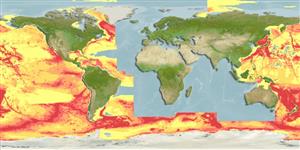Malacostraca |
Amphipoda |
Lysianassidae
Environment: milieu / climate zone / गहराई सीमा / distribution range
पारिस्थितिकी
; गहराई सीमा 0 - 5800 m (संदर्भ 118134). Deep-water
Western Central Atlantic, Western Pacific, Arctic and Antarctic.
Length at first maturity / आकार / Weight / Age
परिपक्व अवधि: Lm ? range ? - ? cm Max length : 5.6 cm TL पुल्लिंग / अलिंग; (संदर्भ 118012); 7.5 cm TL (female)
Caught with baited traps (Ref. 1621). Minimum depth from Ref. 119523. Found in slope and abyss (Ref. 1621). Predator (Ref. 111695) and scavenger (Refs.111695, 118134).
Life cycle and mating behavior
परिपक्व अवधि | पुनरुत्पत्ति | मछलीऔ का अंडे देना | Eggs | Fecundity | Larvae
Members of the order Amphipoda are gonochoric and sexually dimoprhic (males larger than females). Mating behavior: Males locate potential partners with the aid of their antenna to detect the pheromones released by the females; the male then rides or carries the female until the latter is ready to molt. When the female is ready, the male pushes the sperm into the marsupium and releases the female afterwards. A few hours later, the female releases her eggs into the marsupium for fertilization. Life cycle: Eggs are brooded in the marsupium. Eggs hatch into juveniles and remain in the marsupium for a few days. Each species undergo 20 molts at most, i.e., 1-year long life cycle.
Nájera, E. and E. Escobar 2003 Notes on population structure of the scavenger amphipod Eurythenes gryllus from the Central Gulf of Mexico. Deep-Sea Newsletter. (23):8-10. (संदर्भ 1621)
IUCN Red List Status
(संदर्भ 130435: Version 2025-1)
CITES status (संदर्भ 108899)
Not Evaluated
CMS (संदर्भ 116361)
Not Evaluated
Threat to humans
Human uses
| FishSource |
साधन
अधिक जानकारी
Trophic EcologyFood items (preys)संघटक आहारआहार खपतपरभक्षी Life cycleपुनरुत्पत्तिपरिपक्व अवधिFecundityमछलीऔ का अंडे देनाEggsEgg developmentLarvae Human RelatedStamps, coins, misc.
इंटरनेट स्रोत
Estimates based on models
Fishing Vulnerability
Low vulnerability (10 of 100).
Price category
Unknown.
